Neuronal and non-neuronal collapsin-1 binding sites in developing chick are distinct from other semaphorin binding sites
- PMID: 9364065
- PMCID: PMC6573609
- DOI: 10.1523/JNEUROSCI.17-23-09183.1997
Neuronal and non-neuronal collapsin-1 binding sites in developing chick are distinct from other semaphorin binding sites
Abstract
The collapsin and semaphorin family of extracellular proteins contributes to axonal path finding by repulsing axons and collapsing growth cones. To explore the mechanism of collapsin-1 action, we expressed and purified a truncated collapsin-1-alkaline phosphatase fusion protein (CAP-4). This protein retains biological activity as a DRG growth cone collapsing agent and saturably binds to DRG neurons with low nanomolar affinity. Specific CAP-4 binding sites are present on DRG neurons, sympathetic neurons, and motoneurons, but not on retinal, cortical, or brainstem neurons. Outside the nervous system, high levels of CAP-4 binding sites are present in the mesenchyme surrounding major blood vessels and developing bone and in lung. These sites provide a substrate for the collapsin-1-dependent patterning of non-neuronal tissues perturbed in sema III (-/-) mice. The staining patterns for mouse semaphorin D/III and chick collapsin-1 fusion proteins are indistinguishable from one another but quite separate from that for semaphorin B and M-semaphorin F fusion proteins. These data imply that a family of high-affinity semaphorin binding sites similar in complexity to the semaphorin ligand family exists.
Figures
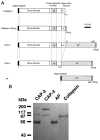
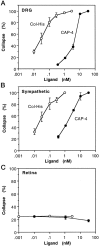

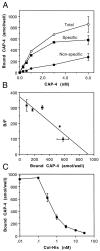
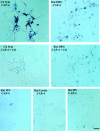


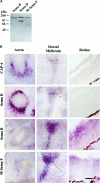
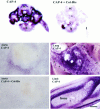
Similar articles
-
Semaphorin 3E/collapsin-5 inhibits growing retinal axons.Exp Cell Res. 2002 Sep 10;279(1):52-61. doi: 10.1006/excr.2002.5595. Exp Cell Res. 2002. PMID: 12213213
-
Growth cone neuropilin-1 mediates collapsin-1/Sema III facilitation of antero- and retrograde axoplasmic transport.J Neurobiol. 1999 Jun 15;39(4):579-89. doi: 10.1002/(sici)1097-4695(19990615)39:4<579::aid-neu11>3.0.co;2-9. J Neurobiol. 1999. PMID: 10380079
-
Rac1 mediates collapsin-1-induced growth cone collapse.J Neurosci. 1997 Aug 15;17(16):6256-63. doi: 10.1523/JNEUROSCI.17-16-06256.1997. J Neurosci. 1997. PMID: 9236236 Free PMC article.
-
Semaphorin-neuropilin-1 interactions in plasticity and regeneration of adult neurons.Cell Tissue Res. 2001 Aug;305(2):275-84. doi: 10.1007/s004410100365. Cell Tissue Res. 2001. PMID: 11545265 Review.
-
Receptors for collapsin/semaphorins.Curr Opin Neurobiol. 1998 Oct;8(5):587-92. doi: 10.1016/s0959-4388(98)80085-8. Curr Opin Neurobiol. 1998. PMID: 9811625 Review.
Cited by
-
The Chemorepulsive Protein Semaphorin 3A and Perineuronal Net-Mediated Plasticity.Neural Plast. 2016;2016:3679545. doi: 10.1155/2016/3679545. Epub 2016 Jan 14. Neural Plast. 2016. PMID: 27057361 Free PMC article. Review.
-
Synaptotoxic Signaling by Amyloid Beta Oligomers in Alzheimer's Disease Through Prion Protein and mGluR5.Adv Pharmacol. 2018;82:293-323. doi: 10.1016/bs.apha.2017.09.007. Epub 2017 Oct 25. Adv Pharmacol. 2018. PMID: 29413525 Free PMC article. Review.
-
Semaphorin 3A controls allergic and inflammatory responses in experimental allergic conjunctivitis.Int J Ophthalmol. 2015 Feb 18;8(1):1-10. doi: 10.3980/j.issn.2222-3959.2015.01.01. eCollection 2015. Int J Ophthalmol. 2015. PMID: 25709899 Free PMC article.
-
Selective induction of neuropilin-1 by vascular endothelial growth factor (VEGF): a mechanism contributing to VEGF-induced angiogenesis.Proc Natl Acad Sci U S A. 2002 Jan 8;99(1):383-8. doi: 10.1073/pnas.012074399. Epub 2001 Dec 26. Proc Natl Acad Sci U S A. 2002. PMID: 11756651 Free PMC article.
-
Cdc42 and RhoA reveal different spatio-temporal dynamics upon local stimulation with Semaphorin-3A.Front Cell Neurosci. 2015 Aug 26;9:333. doi: 10.3389/fncel.2015.00333. eCollection 2015. Front Cell Neurosci. 2015. PMID: 26379503 Free PMC article.
References
-
- Behar O, Golden JA, Mashimo H, Schoen FJ, Fishman MC. Semaphorin III is needed for normal patterning and growth of nerves, bones and heart. Nature. 1996;383:525–528. - PubMed
-
- Camu W, Henderson CE. Purification of embryonic rat motoneuron by panning on a monoclonal antibody to the low-affinity NGF receptor. J Neurosci Methods. 1992;44:59–70. - PubMed
-
- Chen H-J, Flanagan JG. Identification and cloning of ELF-1, a developmentally expressed ligand for the Mek-4 and Sek receptor tyrosine kinases. Cell. 1994;79:157–168. - PubMed
-
- Chen H-J, Nakamoto M, Bergemann AD, Flanagan JG. Complementary gradients in expression and binding of ELF-1 and Mek4 in development of the topographic retinotectal projection map. Cell. 1995;82:371–381. - PubMed
Publication types
MeSH terms
Substances
LinkOut - more resources
Full Text Sources
Miscellaneous
